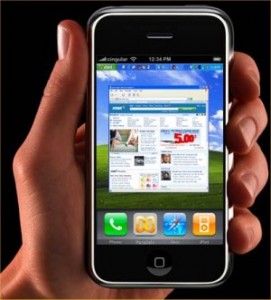This week, I thought I would mention 2 apps, which I use every day.
The link, is that they are both inspired/influenced in some way by books.
In the case of Appigo Todo, it was actually designed around the principles from David Allens book Get Things done.
With Ixpenseit (featured in the apple advertisements) the link is more tenuous. I have long been a fan of Alvin Halls books. In various ways, they talk about recording expenditure. To my knowledge, Alvin had no part in the design of this program, but if you’ve ever used it, it feels like he did !.
Todo, was specifically designed around the principles of GTD. If you really want to know how it works, you should go out and buy the book, but a rough idea is that you capture things in a dependable place, and then organise them in a way so that they can be applied and carried out appropriately.
For example, if your in your house and realise the battery’s in a torch have run down, life has the weird irony, that results in:
A, the torch battery’s will be on your mind on the way to work, while your eating your dinner, while your talking on the phone, therefor partially distracting you, and adding in its own small way to your stress factor.
B, when you are in the supermarket, passing the battery’s, it will never occur to you to purchase replacements, and the cycle will continue.
Personally, Ive always subscribed to the big list/small list idea. I have a mind map for the year, with major concepts and projects on it, and I have a small to do list, with next actions for each of this. If you don’t do it that way, you end up with a massive to do list, which has visit and Cayman Islands, next to buy some milk !.
Whatever system you choose (and you should give significant thought to which one) its still brilliant to be able to jot down an idea, just as it occurs to you. At the very least, it relieves stress, and it always amazes me, after a night out, or a long train/plane journey, just how many good ideas I’ve had.
It also synchs with a website called Toodlodo , so not only is it backed up in realtime, but you can work on your list/lists in full screen, when your at home.
How can you put a price on a good Idea.
In his books, Alvin talks at length about high level financial strategy, but also practical points about day to day expenditure. One example, is cashpoints and magazines.
Imagine you see a magazine you like. You don’t have any cash, so you nip to the cashpoint, withdraw a tenner and buy the magazine. The 2 key points here are A, you just paid the maximum possible amount for that magazine and B, the change from the transaction is unlikely to go back into the bank, and will probably be fettered away on something.
A better strategy would be too get a subscription for the magazine, knocking at least 40% off its cost, and “saving” the £6.50 that would have bought cream cakes etc.
The best way to do this off course, is to record all of your petty cash transactions (this isn’t half as tedious as it sounds) and then look for patterns and places where money can be saved with minimal “damage” to your personal life.
This program is brilliant, as it allows you to do that, but can also plot graphs of where your money is going, what you spent the money on (its only when you evaluate it, you find out just how much you spend on say bottled water). The daily budget feature is especially useful.
It is also able to email a spreadsheet, of all the transactions which makes detailed analysis really easy.
If you’ve got an IPhone, get the apps, and record all your petty cash transactions for 3 weeks. I promise, the results will be startling (and even if they aren’t, you will know who owes you money 🙂


